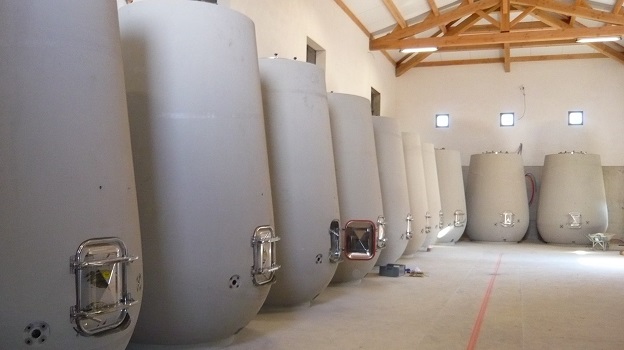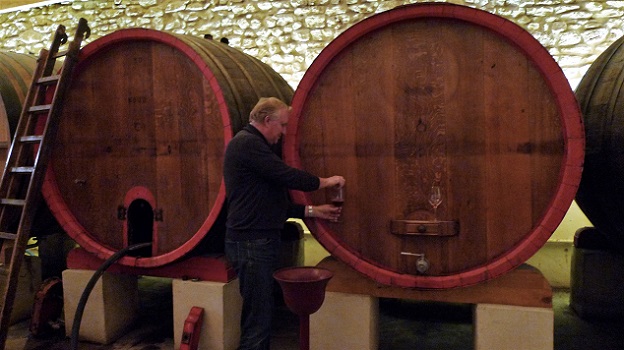Browse using the new Vinous website now. Launch →
Printed by, and for the sole use of . All rights reserved © 2015 Vinous Media
Châteauneuf-du-Pape Reds: The Flamboyant 2014s and the Structured 2013s
Wine lovers who gravitate toward structured Châteauneuf-du-Papes are going to be thrilled by the style of the 2013s, while those who are drawn to more flamboyant, fruit-driven, immediately approachable wines are likely to prefer the 2014s. In fact, the personalities of the two vintages are so different that I can imagine fans of one vintage almost completely dismissing the other, even if the actual differences between the two sets of wines are not generally as extreme as some might think.
Grenache vines in the heart of the village
A Benign Late Harvest in 2014
The growing season of 2014 got off to an auspicious start with warm early-spring weather but was quickly slowed down by a cool, damp late spring and summer. Growers’ spirits were brightened when the weather turned dry and warm, but not hot, in late summer and stayed that way through a late harvest by modern-day standards that extended into mid-October for some vineyards. Acidity levels remained healthy and sugar levels moderate due to the lack of serious heat, which ensured freshness. The protracted harvest yielded mature, healthy grapes and wines with ripe, juicy dark red berry character supported by harmonious tannins, all of which should give the wines considerable early appeal.
Old Grenache plantings on sandy soil at Domaine Charvin
A Difficult Spring in 2013
By contrast, 2013 began with a miserably cold, rain-plagued spring. Temperatures rarely exceeded 40 degrees Fahrenheit through May. Grenache, in particular, had difficulty flowering and the resulting fruit set was down dramatically, especially in younger vines. A warm summer and fall allowed the harvest to take place under very good conditions but the damage had already been done, yield-wise. Sophie Estevin and her sister Catherine Armenier of Domaine de Marcoux, which has an abundance of old Grenache plantings, told me that their overall yield in 2013 was barely 12 hectoliters per hectare, resulting in total production of less than 12,000 bottles of a single classique bottling. Since the Grenache shortage meant that there wasn’t nearly enough fruit, said Estevin, they couldn’t justify making their celebrated Vieilles Vignes cuvée “no matter how high the quality of the wine.”
The shortage of Grenache was a recurring theme throughout the southern Rhône Valley during my two-week visit in February. If producers who typically lean heavily on Grenache for their blends wished to make wines according to their usual formulas in 2013, a choice had to be made. Either they could stick close to their usual recipe and accept the fact that production would be lower owing to the short Grenache crop, or they could increase the proportion of other later-ripening varieties in their blends. While I can’t say that I have tried a lot of 2013s that stray far from most producers’ house styles, many of the wines from this vintage do show more structure and darker fruit character than usual, especially those wines that contain a healthy dose of Mourvèdre.
The best 2013s are built to age, thanks in no small part to the often higher percentages of late-ripening varieties, notably Mourvèdre, that are included in the wines. Then there’s the fact that many producers, as mentioned above, opted to blend the fruit from their oldest vines into a single “basic” bottling, resulting in Châteauneufs that are in many cases more structured and higher in acidity than usual, Grenache being a low-acid variety. That bright acidity actually gives many of the wines early appeal for their freshness, but there’s a backbone to the best wines as well, which makes many ‘13s solid cellar candidates. Generally speaking, my inclination would be to dig into most of the 2014s before—and sometimes even well before—the majority of the 2013s.
Domaine La Barroche's new winery, with ultra-modern, tulip-shaped concrete tanks
News Flash: Châteauneufs are Big, Rich Wines
Grenache is a variety that, when picked underripe, can be anywhere from boring to unpleasantly green. Grenache wants to be ripe, which is why it has found a home in Provence, and ripeness for Grenache means somewhere around 15% alcohol and often higher. Even the most graceful, balanced Châteauneufs will still be substantial, warm, deeply fruity wines compared to, say, red Burgundies or Barolos. So when I make reference to “relatively delicate,” “elegant,” “lithe” or “light on its feet” in my tasting notes, I am not suggesting that these wines be used at the dinner table as Pinot substitutes. These are strictly relative terms when it comes to Châteauneuf-du-Pape.
Vincent Avril in the cellar at Clos des Papes, where the red wines are aged exclusively in large foudres
On The Subject of Drinking Windows
Long-time Châteauneuf lovers may be puzzled by many of the drinking windows that I propose, which I can understand. I have enjoyed more than my fair share of Châteauneufs that were cruising along comfortably into their third and even fourth decade of life (the 1978s, for example), but my experience also tells me that most examples are at their best somewhere between their 8th and 12th birthdays. Beyond that, the wines’ fruit can begin to fade or to become overwhelmed by the often lofty alcohol component that marks so many wines of the southern Rhône, especially in hot vintages like 2007, 2003 and 1998. While I love the complexity that can only come with patient cellaring, given the choice I much prefer to catch my wines on the way up than on the way down.
I tasted the vast majority of the wines reviewed in this article during my visit to the southern Rhône in February, the rest in New York during late winter. Because of the large number of wines in this article, a separate piece on the white wines of Châteauneuf-du-Pape will follow next week.
You Might Also Enjoy
2014 and 2013 Northern Rhône: Great Wines If You Can Find Them, Josh Raynolds, March 2016
Vacqueyras’ Promising 2013s and Ready to Drink 2012s, Josh Raynolds, May 2015
Gigondas — New Releases, Josh Raynolds, May 2015
Châteauneuf du Pape: The Lively 2013s and Lush 2012s, Josh Raynolds, April 2015
The 2013 and 2012 Northern Rhône Wines, Josh Raynolds, February 2015
-- Josh Raynolds
Show all the wines (sorted by score)
- Bosquet des Papes
- Brotte
- Caves Saint-Pierre
- Cellier des Princes
- Chapelle St. Théodoric
- Château Beauchêne
- Château de Beaucastel
- Château de la Font du Loup
- Château de la Grande Gardiole
- Château de Manissy
- Château de Ruth
- Château des Fines Roches
- Château de Vaudieu
- Château du Mourre du Tendre
- Château Fortia
- Château Jas de Bressy
- Château La Nerthe
- Château Maucoil
- Château Mont-Redon
- Château Mont-Thabor
- Château Saint-Roch-Brunel
- Château Simian
- Château Sixtine
- Christophe Mestre
- Clos de l'Oratoire des Papes
- Clos des Brusquières
- Clos des Papes
- Clos des Terres Blanches
- Clos du Calvaire
- Clos du Mont-Olivet
- Clos Saint-Jean
- Clos Saint Pierre
- Cuvée du Vatican
- Delas Frères
- Domaine Albin Jacumin
- Domaine Bois de Boursan
- Domaine Chante Cigale
- Domaine Charvin
- Domaine Comte de Lauze
- Domaine de Beaurenard
- Domaine de Châteaumar
- Domaine de Cristia
- Domaine de Ferrand
- Domaine de Fontavin
- Domaine de la Charbonnière
- Domaine de la Côte de l'Ange
- Domaine de la Janasse
- Domaine de la Mordorée
- Domaine de la Presidente
- Domaine de la Solitude
- Domaine de la Vieille Julienne
- Domaine de Marcoux
- Domaine de Nalys
- Domaine de Panisse
- Domaine de Pignan
- Domaine des 3 Cellier
- Domaine de Saint Siffrein
- Domaine des Chanssaud
- Domaine des Pères d'Église
- Domaine des Relagnes
- Domaine des Sénéchaux
- Domaine du Banneret
- Domaine du Bois de Saint-Jean
- Domaine Duclaux
- Domaine du Grand Tinel
- Domaine du Pegau
- Domaine du Père Caboche
- Domaine du Père Pape
- Domaine Durieu
- Domaine Duseigneur
- Domaine du Vieux Lazaret
- Domaine du Vieux Télégraphe
- Domaine Font de Michelle
- Domaine Giraud
- Domaine Grand Veneur
- Domaine Henri Bonneau
- Domaine Isabel Ferrando
- Domaine Jean Deydier et Fils/Les Clefs d'Or
- Domaine Jean Royer
- Domaine Jérôme Gradassi
- Domaine Julien Masquin
- Domaine Juliette Avril
- Domaine La Barroche
- Domaine L'Abbé Dîne
- Domaine La Boutinière
- Domaine La Consonnière
- Domaine La Crau des Papes
- Domaine Lafond Roc-Epine
- Domaine La Mereuille
- Domaine La Millière
- Domaine La Roquète
- Domaine Les Girard du Boucou
- Domaine L'Or de Line
- Domaine Lou Fréjau
- Domaine Olivier Hillaire
- Domaine Patrice Magni
- Domaine Paul Autard
- Domaine Pierre Usseglio
- Domaine Pontifical
- Domaine Porte Rouge
- Domaine Raymond Usseglio & Fils
- Domaine Roche-Audran
- Domaine Roger Perrin
- Domaine Roger Sabon
- Domaine Saint-Préfert
- Domaine Santa Duc
- Domaine Tourbillon
- Domaine Tour Saint-Michel
- Eddie Féraud
- E. Guigal
- Éric Texier
- Famille Perrin
- Famille Tardieu (Tardieu-Laurent)
- Ferraton Père & Fils
- Gabriel Meffre
- Grandes Serres
- Jean-Paul Daumen
- La Bastide Saint-Dominique
- La Celestière
- La Crau de Ma Mère
- La Fagotière
- La Ferme du Mont
- La Sousto
- Lavau
- Le Clos du Caillou
- Le Moulin des Saints
- Les Cailloux
- Le Serre de Mourres Sabon de Rocheville
- Les Granges des Papes
- Les Halos de Jupiter
- Les Trois Couronnes
- Le Vieux Donjon
- Louis Bernard
- Maison Bouachon
- Maison Chapoutier
- Mas de Boislauzon
- Mas de la Grange Blanche
- Matteo Pictor Pape
- Ogier
- Olivier Ravoire
- Patrick Galant
- Paul Jaboulet Aîné
- Pierre-Henri Morel
- Rotem & Mounir Saouma
- Saint-Cosme
- Sélection Laurence Féraud
- Simon Alexandre
- Vignobles Mayard




